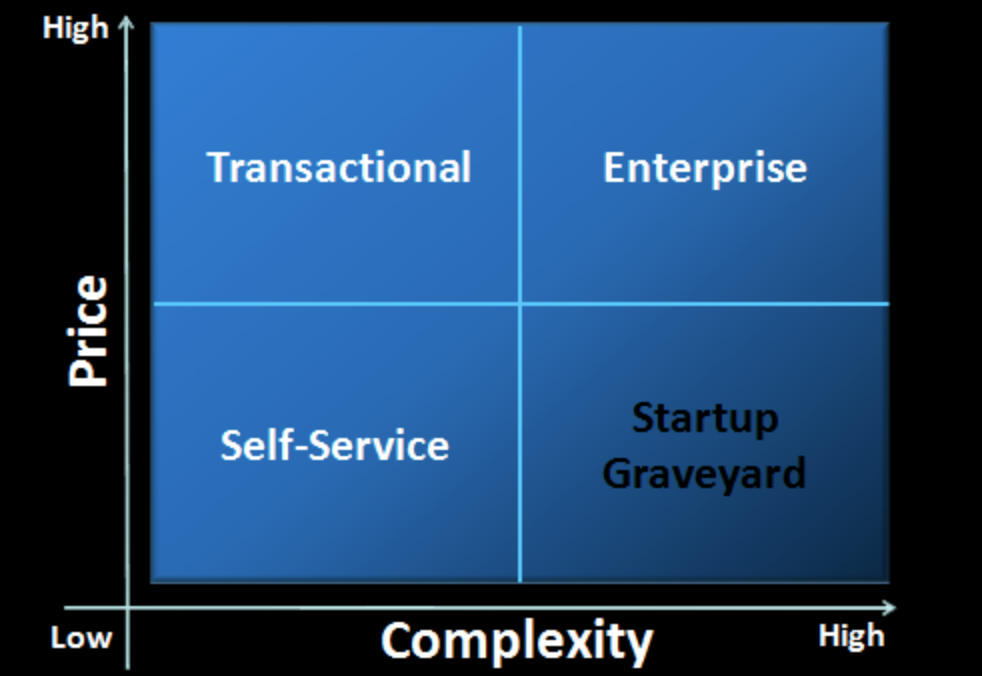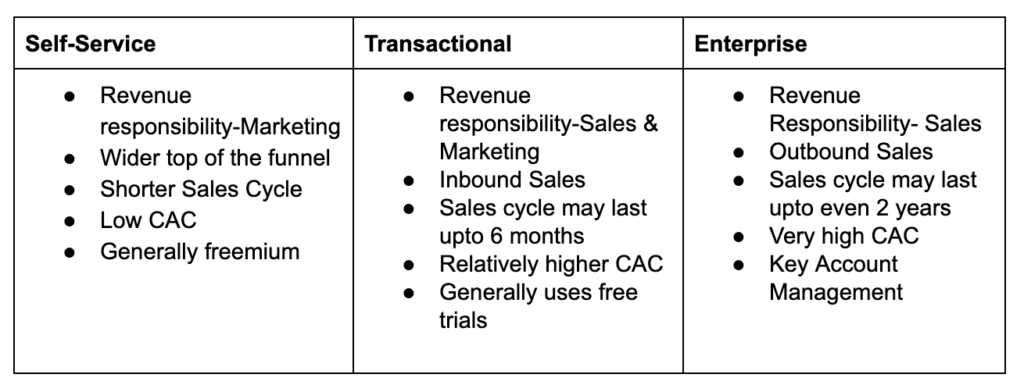According to a study by McKinsey, if a SaaS company is growing at 20% annually, it has a 92% chance of ceasing to exist within a few years. Many SaaS companies fail to achieve sustained growth even after getting sufficient funding and testing for the product-market fit. What do you think could be the reason?
It’s getting the sales model right.
The right Sales Model is the topmost recipe for sustained growth.
Wondering what factors determine the right Sales model?
- Price– Price is an important factor in determining the Sales model because price places a cap on the CAC. For example, assuming the ASP of a product X to be $600 in ACV ($50/mo) and given the average salary of the SaaS sales executive to be $80k in the US (according to GlassDoor), a salesperson needs to close more than 133 deals for the company to cover the direct sales force cost. However, if the ASP of the product is $90k in ACV, then closing only one deal would suffice. When the price is low, the business must play the volume game and rely on sales automation since the sales force is expensive.
- Complexity– Complexity creates friction between your product and the customer. Complexity can range from the complexity of the product, the complexity of implementation or even the buying decision. Complexity is important in determining the Sales Model because higher the complexity, higher the sales cycle. Higher sales cycles may reduce sales velocity and thus, conversion rates.
- Target Market– Target market is a very important determinant of SaaS sales model. As a B2B SaaS founder, whether you are targeting SMBs, Mid-level businesses or Enterprises determines your Go-to-market strategy.
Some important components of a Go-To market strategy that we’ll talk about in the blog and that are often overlooked by founders are organizational structure, roles and responsibilities of various departments, the relationship between the departments such as Marketing, Sales, Customer Support etc and with customers.
Assuming that you know your target market and have tested for the product-market fit, we will talk about how the spectrum of price and complexity combinations can help you get your Sales Strategy right. There are three major SaaS Sales models: Self-service, Transactional and Enterprise.

Self service
In the self-service model, the user visits your website, signs up for a free trial and purchases the product if he/she finds value in the product. This entire process does not involve speaking with a salesperson.
This SaaS Sales Model model works best when:
- Your target customers are already looking out for a solution for their pain point that your product solves
- The price of your product is low. The price range for the self-service model lies in the range of $1 to $1k in ARR
- The complexity of your product is low in terms of use and implementation.
If your product meets these three criteria, your audience would be willing to try your product and service themselves.
Let’s take an example: Calendly is a tool that helps people schedule meetings without any hassles. People no longer have to deal with a number of emails to agree on a particular meeting time. It is an easy to use tool and has improved the productivity of thousands of people. It offers a free trial for 14 days after which you have to pay to unlock features that are not present in the basic version. Since the price of the premium version and the pro version are $8 and $12 respectively, users do not need to think twice or take any approvals from the management for upgrading the plan.
Calendly Pricing (Self-Service SaaS)
The product has experienced virality since every time a person schedules a meeting via Calendly, he/she promotes the product to the invitee. The invitee by booking a meeting without any hassles experiences the value of the product first-hand (the “Aha moment”). This leads to a viral loop.
Calendly is a perfect example of how a low priced product, with low complexity, helps its users derive value from the product immediately. By helping the users reach their “Aha” moment quickly, Calendly has been able to reduce its sales cycle and increase conversion rates.
- Sales: No responsibility
- Marketing: Owns the entire responsibility from awareness to purchase; full revenue responsibility
- Customer Support: Chatbots, FAQs and other educational content that would help the customers resolve the problem on their own
Transactional
As the price increases, customers’ expectations also increase. They expect higher credibility in return for a higher price. They seek proper business relationships and the ability to speak with someone if anything goes wrong with the product. Therefore, this risk aversion needs to be compensated with a shift from the self-service model to a Transactional Model.
The price range for transactional SaaS usually falls in the range of $1k in ARR and above. With higher prices, the budget approval process also takes time in an organization because it involves top-level employees. Therefore, the sales cycle becomes longer than that in the self-service model and can last up to 6 months on an average.
Let’s take an example: Hubspot Marketing Automation Software helps marketers convert visitors to leads, optimize their website without the help of IT, understanding the impact of marketing on the bottom line and much more. Since the price of the software is high, its customers seek interaction with humans both pre-sales and post-sales. Therefore, it provides one on one onboarding support to all its customers.
Hubspot Marketing Automation Software Pricing (Transactional SaaS)
- Sales: Businesses with Transactional sales models use inbound sales. The inside sales reps are well equipped with material from the marketing team that increases their efficiency.
- Marketing: The marketing team feeds the Sales team with well-qualified leads and also responsible for providing them with ebooks, email templates, collaterals etc. required to make a sale.
- Customer Support: Customer support is responsible for building relationships with customers post-sales and converting them to loyal customers. The key accounts are assigned with dedicated account managers who not only understand the past and the present of the customer’s business but the future as well.
Enterprise Sales Model
Products that are highly complex and highly-priced cannot be sold without high-touch sales. Enterprise Sales is characterised by long Sales Cycles which may last up to two years or even more. It also involves SLAs and security guarantees. Selling such a product requires elaborate demonstration and implementation support. Since Enterprise SaaS has higher ACV, the high CAC gets compensated. The product also undergoes customizations according to the needs of the target customer.
Let’s consider the example of Workday, an enterprise SaaS product. Workday is an enterprise SaaS solution that helps enterprises with financial management, human resource management and planning. Both the complexity and the price of Workday are so high that it provides high-touch sales and support to its customers to help the customers configure the product.
Workday Pricing (Enterprise SaaS)
- Sales: Enterprise Sales is usually characterized by outbound sales. The sales reps focus on a narrow set of target customers. They usually do a lot of research on every prospect before approaching them.
- Marketing: Marketing works on creating brand awareness. To support Sales, it creates highly personalized collaterals, ROI calculators etc.
- Customer Support: Enterprise Sales model involves high touch support, which involves the on-site resolution of the issues if required. Each account has a dedicated account manager to help the client succeed with the product.
Startup Graveyard
If your software is complex, you need to handhold your customers to understand the product. Doing so may increase the cost to the extent that the costs may exceed the price/ACV. When this happens, your startup is bound to fail and fall into the Startup Graveyard.
Whenever a startup finds itself in a startup graveyard, it should follow the following strategies:
1) Product Modifications: Move towards self-service SaaS by driving out complexity through product modifications.
2) Improve value proposition: Move towards Enterprise Sales strategy by improving value proposition and thus charging a higher price.
3) Increase operational efficiencies: Move towards Transactional SaaS by improving operational efficiencies by lowering CAC and raising price.
Summary


